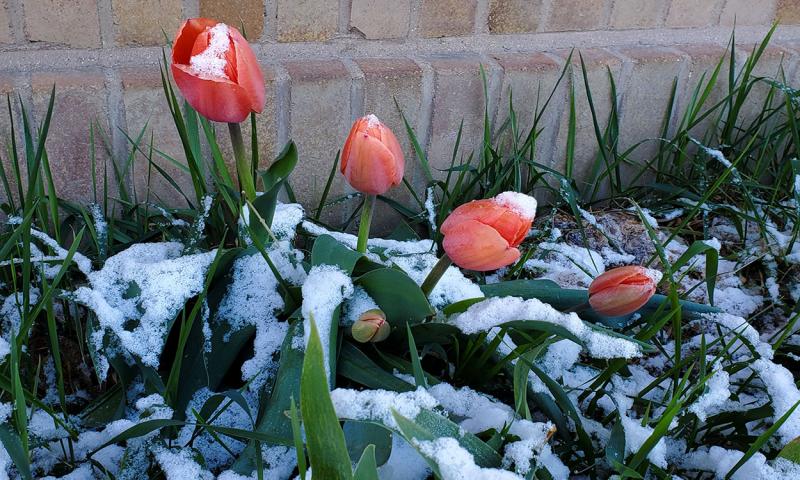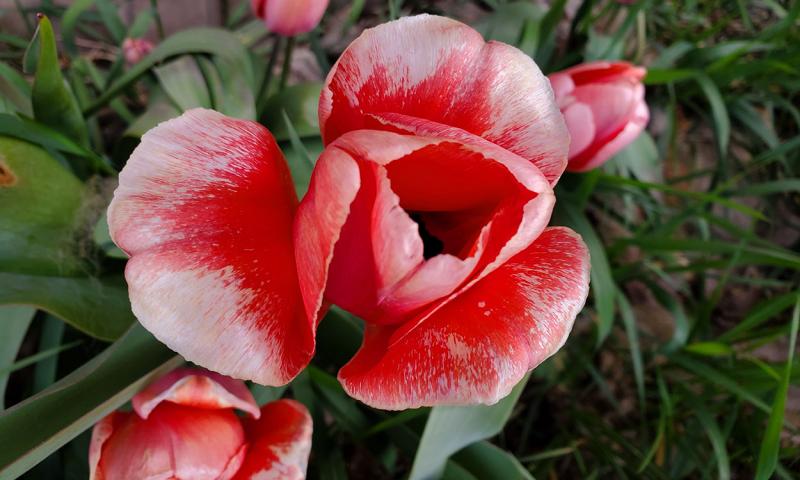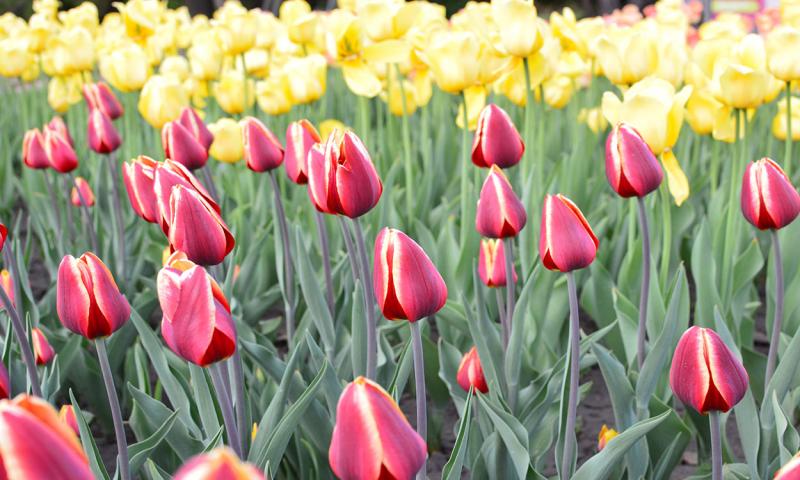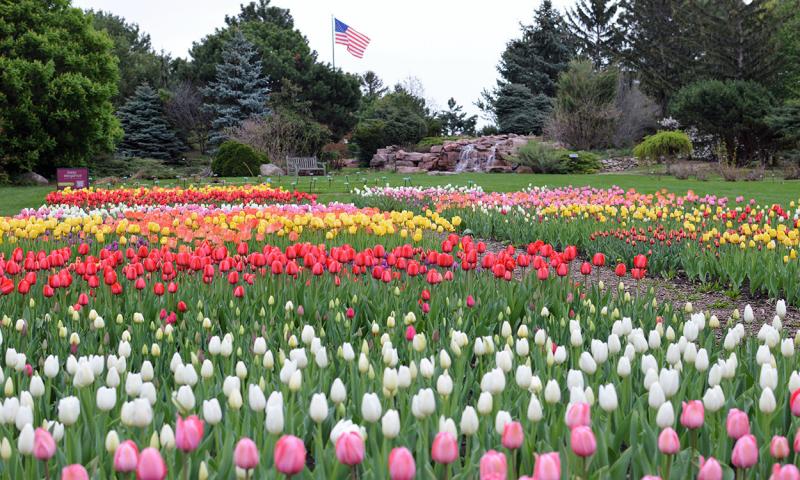Nothing says “spring is here” quite like the annual tulip bloom. Late April and early May are great times to enjoy a wide pallet of colors and textures presented by over 100 known species of garden tulips that bloom in a multitude of bright colors. The tulip bloom will begin earlier in sheltered locations next to buildings that have acted as heat reservoirs, with tulips planted in open areas following suit shortly after. By understanding this garden beauty and with a few tulip growing tips, you can enhance the color in your spring garden with relative ease.
Tulips are true bulbs. A bulb is a specialized underground storage structure that contains a short, fleshy stem. The growing point of the tulip emerges from a basal plate, which separates the shoot and the roots. In the center of a typical tulip bulb are leaf shoots and a flower stalk, protected by outer bulb scales that contain stored food. Tulip bulbs are considered “tunicate,” as they have multiple scale layers that protect the bulb. The outer layers serve to protect the bulb from drying and from mechanical injury during harvest and transportation.

The lifespan of an average tulip bulb is two-to-five years. Midwestern gardeners plant tulip bulbs in the fall, so that they will flower the following spring. Temperature is the most-important factor in tulip growth and flowering. This annual cycle is defined as warm-cool-warm. When tulip bulbs are planted in the fall, the optimum temperature range of 63 to 68 degrees Fahrenheit allows for root growth and below-ground shoot development. A subsequent cool period with temperatures of 35-to-48 degrees for 13-to-20 weeks signals the initiation of flower formation within the bulb. In Midwest gardens, this cold period is achieved naturally in the winter months. The soil surrounding the bulb aids in protecting the bulbs from extremely cold temperatures. In the spring months, once the soil temperature is 50 degrees and rising, the flower matures within the tulip bulb. When temperatures consistently reach the low 60s, the flower stalk emerges, elongates and blooms within three-to-four weeks.

Fluctuating spring temperatures and light snowfalls that occur in South Dakota might worry some tulip lovers; however, tulip foliage and closed flower buds are able to withstand light freezes for short periods of time. Mature tulip bulbs have greater cold hardiness, so freezing temperatures need to last 24 hours or more for extensive damage to occur to the foliage and buds. Prolonged periods of spring temperatures below 23 degrees can result in failure of the shoot to elongate and flower death. Tulip foliage can withstand light snowfalls, although open flower blossoms may be susceptible to damage from snowfall and low temperatures (Figure 1). White or yellow patches on tulip petals and foliage is a sign of freeze damage (Figure 2). You should not cut back damaged foliage unless it is completely wilted, as remaining green areas will contribute to valuable photosynthesis later.
Tulips are reproduced through bulblets (also called daughter bulbs). Bulblets are produced within the underground bulb scales. Typically, bulblets only generate one leaf shoot during the first year of growth and this shoot supports the increase in size and weight of the bulblet below. The average bulblet is supported by the energy reserves of the “mother” bulb for an average of two growing seasons before becoming a bulb that is large enough to flower on its own. The original bulb that supported the bulblet will have died back by this point, with the cycle of reproduction continuing as new bulblets continue to form on maturing bulbs.
With a deeper understanding of tulip physiology and the desire to add to tulips to your own garden, you’ll be faced with the sometimes overwhelming, but also fun task of selecting which cultivars of tulips to plant. Tulips are organized into multiple classes based on the flower type, such as Darwin (short, round petals), Double Early (double flower, early bloomer), Fringed (petals with fringed edges) and Parrot (feather-like petals, sometimes in multiple colors). Within each category of flower type, there are many cultivars to choose from. Order bulbs by mail from reputable sources or visit your local garden center in August and September to see the options available. When selecting tulips in the fall, be sure that they are winter hardy to Zone four or five based on where you live. See the USDA Plant Hardiness Zone Map for South Dakota for more information.

The size of a tulip bulb is the primary factor that influences flowering. In general, if tulip bulbs are less than 2.5 inches in circumference, flower initiation will not occur. For this reason, gardeners should plant tulip bulbs with a circumference of four inches or greater to ensure flowering the following spring. Tulips are typically planted in September and October. Plant the bulbs five-to-six inches deep, ensuring that the nose of the bulb (the pointed portion) is oriented up. In soils that are high in clay and described as “heavy,” tulip bulbs should be planted one-to-two inches shallower to allow for the foliage and flower shoot to emerge from the soil without issue. Tulips should be planted four-to-six inches apart and in clusters rather than single, straight lines.
A two-to-three-inch layer of organic mulch (shredded bark or straw) will hold moisture, prevent freeze injury and protect the tulip bulbs from soil temperature fluctuations, especially during premature spring warm spells. Tulips are not photoperiodic, so the length of daylight does not influence flowering. However, they should be grown in full sun to maximize photosynthesis that is essential for overwintering bulbs and growing bulblets.
Public gardens, cut flower producers and many gardeners treat tulips as annuals in the interest of having the largest, showiest bloom possible. Spent bulbs are removed in May after they have bloomed, and fresh bulbs are planted each fall to ensure the greatest crop the following spring.

If you choose to treat your tulips as perennials, there are several things you can do to prolong plant performance. First, cut back the flower stalk after the petals have fallen off but before the tulip expends energy setting seed. Do not remove the tulip foliage until it has yellowed and died back naturally. The tulip foliage is necessary to allow for adequate photosynthesis and transport of sugars back into the bulb for the next year’s bloom. Tulip bloom performance may start to decline three-to-four years after the initial planting, as more bulblets are sending up shoots and competing for space. Tulip bulbs can be dug up and divided to alleviate crowding after all foliage has died back in June or July. Select the largest bulbs to store in a cool, dry location for replanting in the fall.
As you explore your neighborhood in the spring, be on the look-out for tulips, and use this as an opportunity to gain new ideas for your garden. Keep a list of what you would like to plant in the fall so you can enjoy blooms in the spring. If you need inspiration for your tulip planting plan, make plans to visit South Dakota State University’s McCrory Gardens in Brookings, South Dakota. There you can view the latest tulip cultivars that are hardy to South Dakota and create your fall planting list. McCrory Gardens highlights the spring tulip bloom each year during its annual TuliPalooza where over 10,000 tulips are on display (Figure 3 and Figure 4).
Special thanks to SDSU Extension Master Gardeners Tim Schreiner and Stacy Dreis for serving as volunteer copy-editors of this article.


